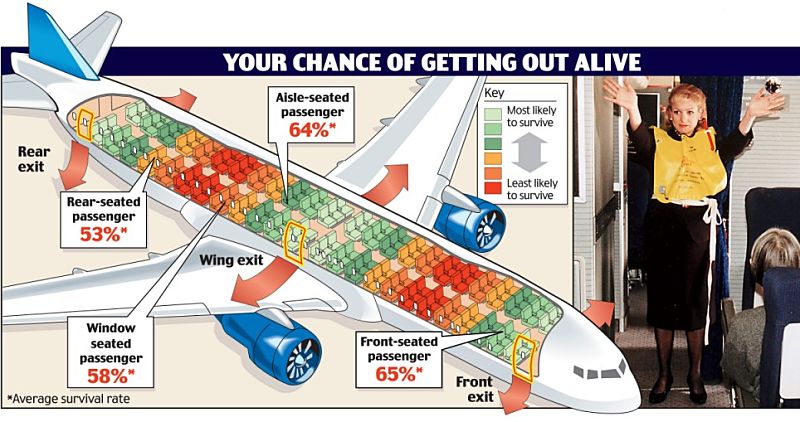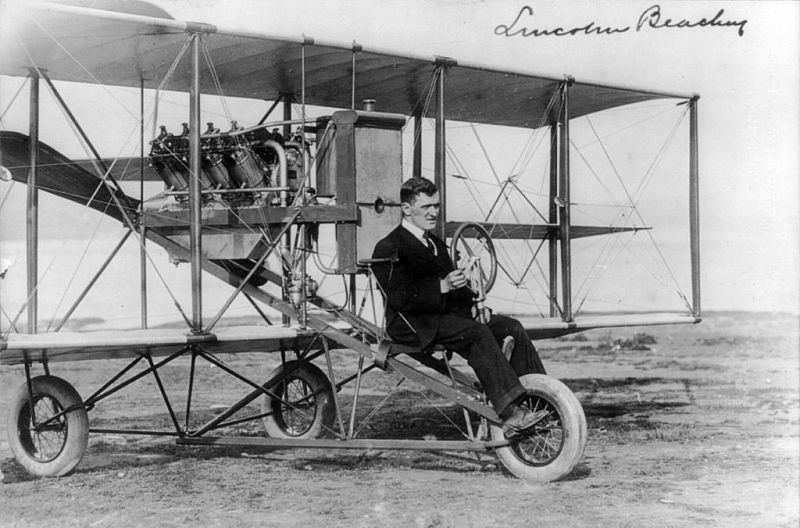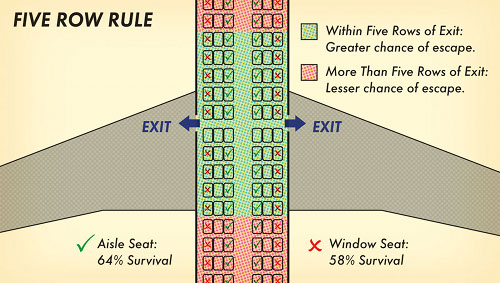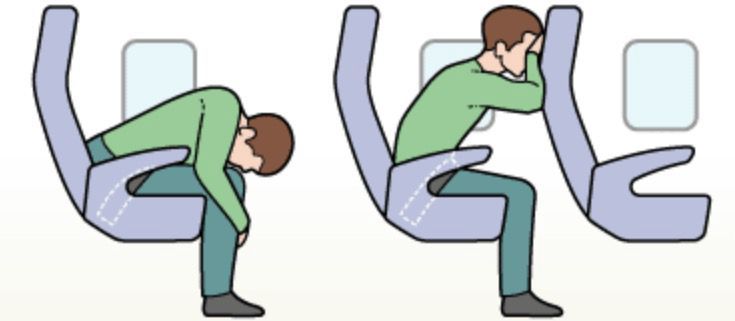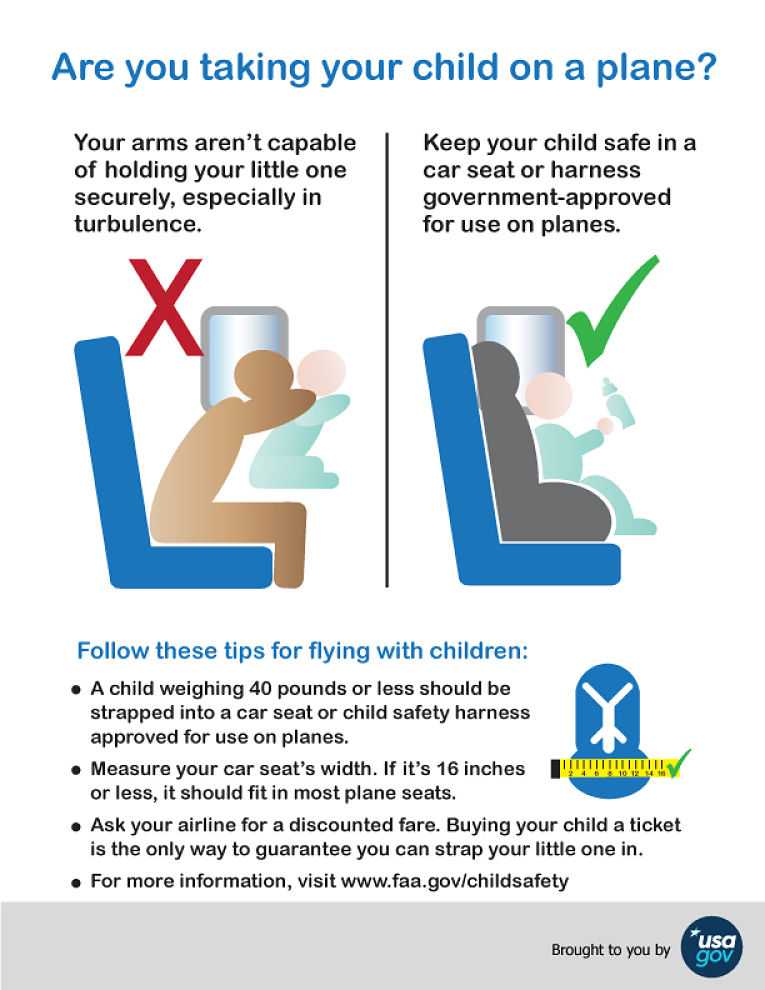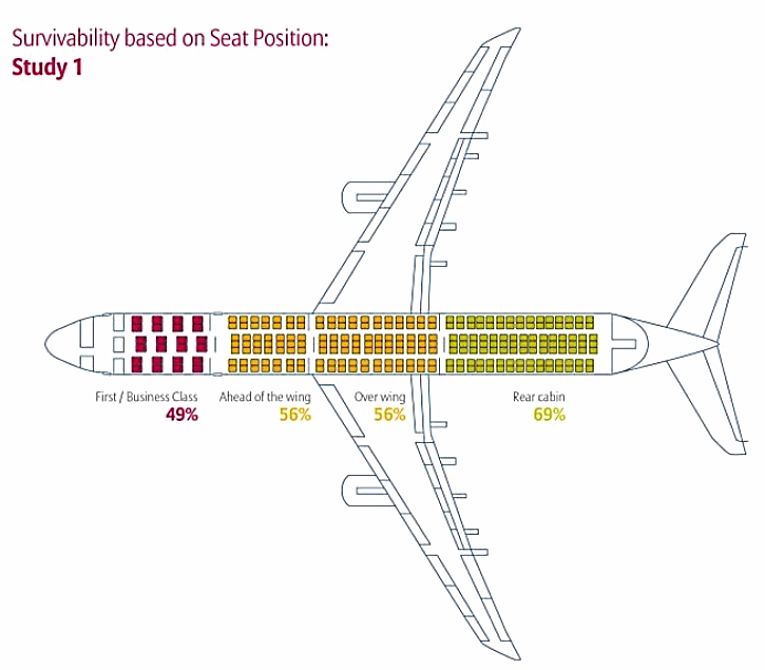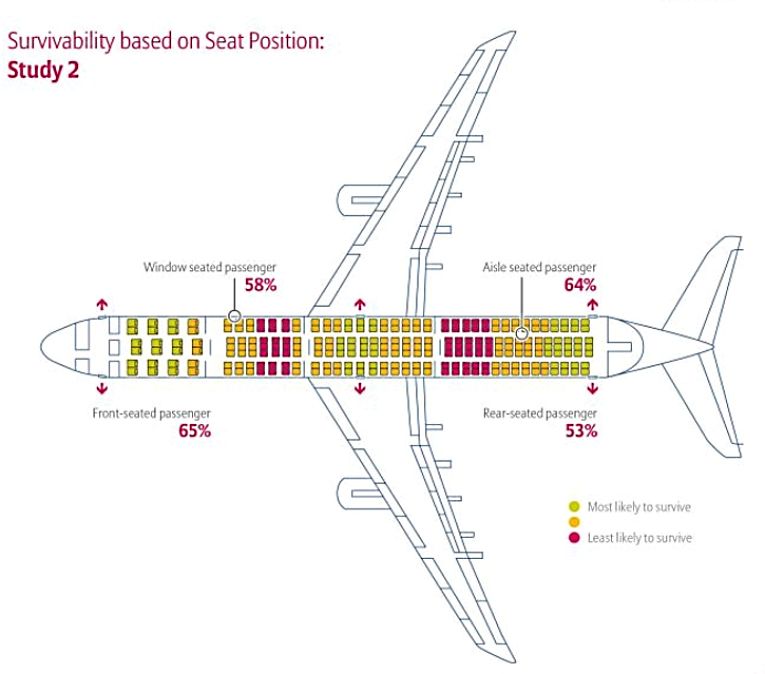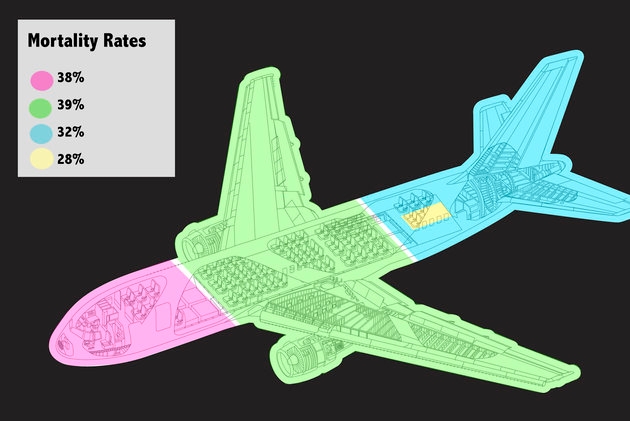Safe Seats Airplanes, Where to Book Your Seat and Best Brace Positions
Perish the thought, but if the next airplane crashed would any seating position on the plane give you a better chance of survival?
Also despite most people ignoring the pre-flight lecture, does the brace position really make a difference and how does it vary depending on where you sit.
Interestingly, do the most expensive (first class) and most coveted seats on the plane, in front and behind the wing, provide more or less vulnerability?
Are their risk benefits in choosing seats close to the emergency exits?
This article summarizes the latest research and advice on choosing the safest seat on airplanes.
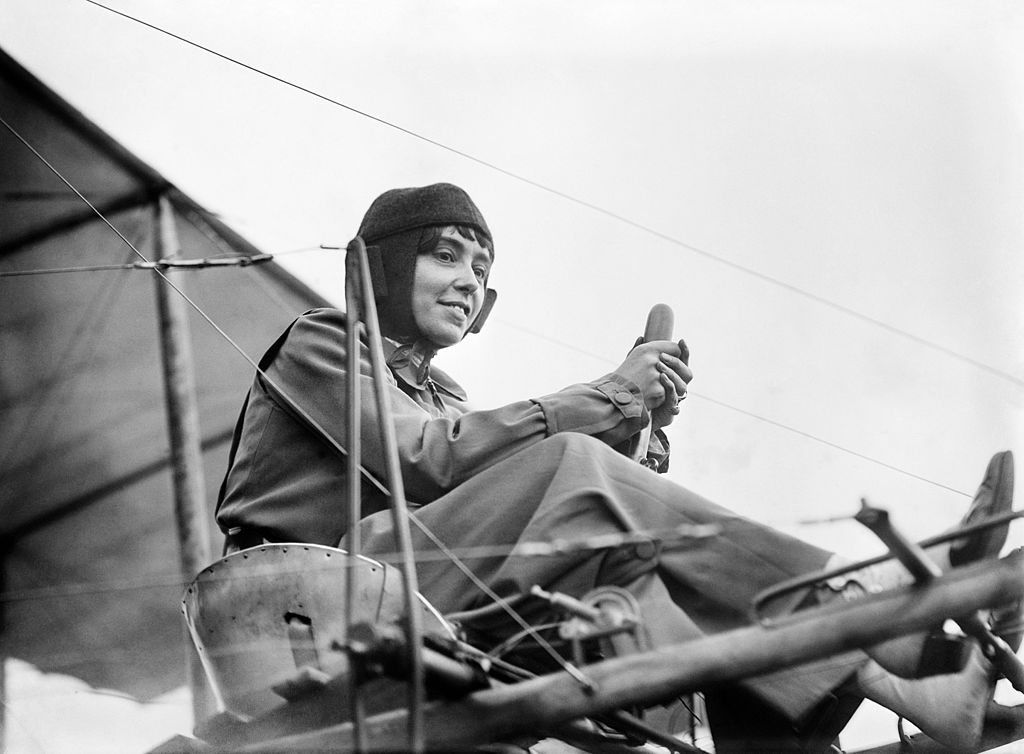
How Safe is Flying?
The accident rate for the airline industry in the West is very low.
The comparison with other modes of transport is complicated by the longer travel distances for airplanes and the fact that fewer people fly than drive cars.
It is often stated that air travel is 12 times less risky than traveling by train and over 60 times safer than traveling by car.
However these statistics relate the mortalities in terms of distance traveled.
If mortalities are counted per hour, or other of times traveled, trains and planes have similar risks and cars are only four times more risky.
If the statistics are calculated on a per trip basis, ignoring the distances or times, cars are three times safer than planes and trains are six times safer than planes.
Additional comparisons are provided in the tables below.
Mortality Rate per Passenger Miles Travelled
|
Mode of Travel
|
Mortality rate per billion passenger miles traveled
|
|---|---|
|
Car
|
7.2
|
|
Airplane
|
2.3
|
|
Bus
|
2
|
|
Train
|
0.5
|
Risks of Various Types of Transportation per head of Population
|
Country and Road Traffic Accident Type
|
Mortality rate per 100,000 population
|
Annual odds (1 in)
|
Lifetime odds (1 in)
|
|---|---|---|---|
|
Motor vehicle
|
|
|
|
|
US
|
15.44
|
6,478
|
82
|
|
UK
|
5.66
|
17,655
|
240
|
|
Pedestrian
|
|
|
|
|
US
|
1.73
|
57,657
|
730
|
|
UK
|
1.15
|
87,197
|
1104
|
|
Motorcyclist
|
|
|
|
|
US
|
1.56
|
63,989
|
810
|
|
UK
|
1.02
|
98,260
|
1244
|
|
Cyclist
|
|
|
|
|
US
|
0.28
|
358,957
|
4544
|
|
UK
|
0.25
|
403,137
|
5103
|
|
Airplane
|
|
|
|
|
US
|
0.02
|
4,406,209
|
55078
|
|
UK
|
0.03
|
3,530,815
|
44135
|
|
Train
|
|
|
|
|
US
|
0.0007
|
149,699,242
|
1871241
|
|
UK
|
0.02
|
5,885,800
|
73573
|
Which is Safer - Front or Rear Seats in Planes?
Research conducted for a television documentary program by Channel 4 in Britain, showed that the seats at the front of the plane, where most ‘first class’ seats are located were the most vulnerable in the event of a nose-first crash. This seems to be common sense for moderately severe crashes rather than the catastrophic ones where everyone is killed. For the program test dummies were fitted with impact-force sensors and were installed in a Boeing 727 plane that was sent nose first into the ground in the Sanoran Desert in New Mexico.
The outcome from the crash test was that the front of the fuselage area was crushed as expected. However there were other benefits for sitting further back. The force of the collision on the test dummies, declined further back in the plane from, down from 12G (12 times the force of gravity) to about half (6G) near the back of the plane.
The results also showed that about 80% of people sitting at the back would have survived the test impact of the plane (provided there were no fires or fumes).
These tests supported the conclusions from similar studies reported revealed by the magazine Popular Science (see the image) and other studies. The magazine gathered crash statistics and found that survival rates were:
- 70% in the rear
- 55% over the wing
- 49% in the front of the plane
How Important is Proximity to Emergency Exits?
Despite common opinions, most victims of plane crashes actually survive. Statistics from 568 plane crashes in the USA, 1993-2000 showed that about 90% survived. This included a range of severity of crashes. However, about 50% of people survival the group of worst crashes.
One of the biggest hazards to people who survive the impact itself is fire and fumes. It would appear obvious that being closer to an exit would increase your chance of getting out of the plane after it crashed. This also applies to aisle seats versus window seats.
A study of 105 plane crashes by the University of Greenwich, from which 2000 people survived confirmed these suggestions. People who sat more than 6 rows from one of the emergency exits had lower survival rates. There were differences between aisle and window seats, but the differences were not significant. The results are summarized in the image and the table below.
Effect of Seating Position on Chances of Surviving
|
Seating Position
|
Average Survival Rate
|
|---|---|
|
Front - Close to Exit
|
Good (green)
|
|
Front - Further from the Exits, in front of Engines
|
Very Poor (red)
|
|
Front - Just in Front of the Wings, Closer to exits
|
Moderate (amber)
|
|
Centre, over the Wing, near central exits
|
Good (green)
|
|
Centre, over the Wing, futher from central exits
|
Moderate (amber)
|
|
Centre, over the Wing, remote from exits
|
Very Poor (red)
|
|
At the Rear, closer to Rear Exits
|
Moderate (amber)
|
|
At the Rear, further from Rear Exits
|
Very Poor (red)
|
|
Right at the Rear, next to Rear Exits
|
Good (green)
|
|
Aisle Seats
|
Better
|
|
Window Seats
|
Poorer
|
Does the Brace Position Really Work?
Despite airlines promoting the idea of the 'brace position' there is very little information about how effective it is and exactly what it is supposed to do. Numerous theories have been proposed about the purpose of the procedure. The absence of fatalities on board the famous US Airways Flight which landed on the Hudson River, with no fatalities, was linked with most passengers adopting the brace to the position.
Anecdotal studies by the renowned Mythbusters program also show the merits of adopting the brace position. The study mentioned above, conducted by the Channel 4 program used dummies: one was placed in the recommended brace position, with a seat belt fastened, one with no bracing but with a seat belt fastened and the last one without bracing or a seat belt. The results suggested that the dummy with no seat belt would have died, the one with a seat belt, but no bracing would have probably survived severe head injuries. The only one to have survived with minimal injuries was the dummy that was places in the brace position.
The recommended brace position varies depending on your seat allocation and whether or not you can reach the seat in front of you. Start by push back into your seat that has been shifted to the upright position. Make sure your safety belt is securely fastened.
Brace Position if the Seat or Bulkhead (wall) is out of reach:
- Bend the upper body forward as far as you can with the chest resting on your thighs and knees.
- Hold your head down as low as possible, testing on your thighs and legs.
- Tuck your arms against your body and lock them around or behind your legs
- Place your feet flat on the floor
- Position you lower legs so that they are angled back behind the knee joints
Brace Position if the Seat or Bulkhead (wall) is within reach:
- Bend the upper body forward as far as possible.
- Position you head so that it touches the bulkhead or seat back in front of you and brace against it.
- Place you hands, one on top of the other and lay them on to of your head. Don't interlock the fingers.
- The forearms should be tucked in firmly against both sides of the face.
- Position you lower legs so that they are angled back behind the knee joints
- The feet should be positioned flat on the floor.
